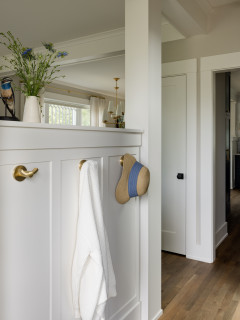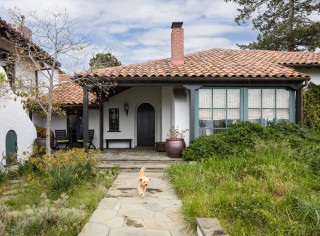
This article was originally published by a www.houzz.com . Read the Original article here. .

This article was originally published by a www.houzz.com . Read the Original article here. .

Kitchen at a Glance
Who lives here: A couple with four kids
Location: Shelburne, Vermont
Size: 353 square feet (33 square meters)
Designers: Jillian Bartolo of Peregrine Design Build (lead designer) and Lauren Miles (interior design)
Bartolo removed a structural wall to absorb the former dining room into the new kitchen, increasing the layout by 155 square feet. “We ended up relocating the dining room across the house,” says Bartolo, who worked with Miles on selecting finishes.
A 4½ -by-10-foot island with a flat-sawn white oak countertop creates a warm and welcoming spot for the family to gather. “It was my recommendation to go with a 2-inch-thick top that’s dramatic and creates a focal point,” Bartolo says. “For the scale of the island that big, the thickness is appropriate.”
Custom Shaker-style wood cabinetry is painted a warm green (Shade-Grown by Sherwin-Williams). A 36-inch paneled built-in refrigerator column and 30-inch paneled freezer (back right) and paneled dishwasher to the left of the sink help maintain the warm and inviting look. The wood-and-green palette join engineered wide-plank European white oak flooring, hand-painted marble backsplash tiles and marble perimeter countertops for an inviting English country look and feel.
A pocket door next to the refrigerator leads to the renovated mudroom, which has slate tile flooring. To the right of that doorway, on the white wall, is another pocket door (not shown) that opens to a spacious butler’s pantry.
Backsplash: Willow in Walnut, Artisan Stone Tile, StoneImpressions; paint colors: Ivory White (ceiling and trim) and Tapestry Beige (walls), Benjamin Moore; cabinetry: Pomerantz Woodworking; flooring: Tresor collection, Provenza Floors
Find kitchen remodelers near you
This article was originally published by a www.houzz.com . Read the Original article here. .

Plants here include ‘Caradonna’ sage (Salvia nemorosa ‘Caradonna’, USDA zones 4 to 9; find your zone), lamb’s ears (Stachys byzantina, zones 4 to 9), white Jupiter’s beard (Centranthus ruber ‘Albus’, zones 5 to 8) and ‘Walker’s Low’ catmint (Nepeta racemosa ‘Walker’s Low’, zones 3 to 8).
“I call this the Carpinus bank,” Davies says, referring to the row of five box-pruned hornbeams that punctuates the stretch. The clipped trees echo the thatched roof. “There’s a sense of the thatch being a clipped material,” he says.
Note: Lamb’s ears and Jupiter’s beard can be aggressive spreaders, depending on where you live and your garden’s conditions. Check with a landscape designer or your local nursery before planting.
This article was originally published by a www.houzz.com . Read the Original article here. .

This 1920s Spanish Colonial home in Kensington, California, has quite a history, including being the residence of J. Robert Oppenheimer during his time at the University of California, Berkeley. However, the home’s funky kitchen didn’t share that history; it was added on to the back of the home in the 1970s. The homeowner, who loves to cook and to host her grandchildren, looked to Houzz to find a designer when she was ready to remodel. She found interior designer Anne Norton, who came up with a design that would lighten the space and tie it in with the rest of the historic architecture.
Kitchen at a Glance
Who lives here: A woman and her dog, Teddy
Location: Kensington, California
Size: 252 square feet (23 square meters)
Designer: Anne Norton of AND Interior Design Studio
Before we step inside, take a look at this photo, which shows the home’s classic 1920s Spanish Colonial architecture. It also introduces us to the homeowner’s dog, Teddy.
The homeowner wanted her kitchen to flow with the rest of the home’s historic architecture. “She’s a big cook, she even likes to make her own yogurt and kombucha,” Norton says. She also loves to gather around the kitchen table with friends and family, especially her grandchildren.
Find a local interior designer on Houzz
The dining room and the other original rooms had high ceilings. But the kitchen addition had a low, flat ceiling covered in dark wood.
Shop for a chandelier
The cabinets were dark-stained Douglas fir, the wood on the ceiling had a dark stain, and the floors were dark. “The layout was good but there wasn’t enough storage,” Norton says. “We also wanted to upgrade the cabinetry with doors and drawers that were easy to open. The goal was to modernize the kitchen while making it feel like it was part of the original architecture.”
With the other elements in the kitchen lightened up, Norton kept the dark floors. “I am a big believer in ‘If it ain’t broke, don’t fix it,’” she says. A Middle Eastern rug adds lightness. “I like the way the soft pale oranges in the rug juxtapose with the green cabinets,” Norton says. “It brings a lot of dynamism to the space.”
Browse dining tables in the Houzz Shop
The cabinet profiles are flush inset with simple lines and hardware. And they’re also modern, with lots of inserts and features like spice pullouts, a panel-front dishwasher and trash-recycling pullouts. They have full-extension door and drawer slides, meaning they extend out from the cabinet the full length of the slide when opened, not the typical 75%.
Norton chose Benjamin Moore’s Carolina Gull paint for the cabinets, bringing in a soft, nature-inspired color. The hardware is oil-rubbed bronze. “It will patina over time,” Norton says. This will lend a sense of age that matches other details in the home.
Find a local cabinet pro
The cabinets on either side of the vent hood have decorative metal mesh inserts that give them a lighter feel. Also, Norton had the marble backsplash tiles hand-cut into 4-by-8-inch rectangles. This gives them a stronger presence than if standard 3-by-6-inch tiles had been used.
Norton wanted to create just the right spot for the homeowner’s Keith Haring subway art. “That wall where the art hangs was a wood grid of 12-by-12-inch cubbies that made no sense, so we took them out,” she says. She replaced them with a plastered wall that lightened the room and gave the owner a spot to hang the beloved artwork.
The large windows overlooking the back garden were a great feature of the 1970s addition. “There is a view of wisteria hanging from a trellis, and her chickens come up and look through the windows. I always leave this house loaded up with a dozen eggs,” Norton says with a laugh.
This article was originally published by a www.houzz.com . Read the Original article here. .
House at a Glance
Who lives here: A woman
Location: Seattle
Size: 1,506 square feet (140 square meters); three bedrooms, 1½ bathrooms
Designer: Tammara Stroud
Contractor: Dave Headland of Headland Construction
The entry reveals a view straight back to the kitchen, to the dining room toward the back left and to the living room on the other side of the half wall seen here. The door opens to a coat closet.
“The one thing my client really wanted in here was hooks for her friends to hang their purses up,” Stroud says. This keeps them off her kitchen counters.
“The house was sinking. The foundation needed to be jacked up and the floors needed to be leveled,” Stroud says. This meant replacing all the flooring. The new hardwoods create consistency throughout the first floor, add warmth and suit the home’s age.
Find an interior designer on Houzz